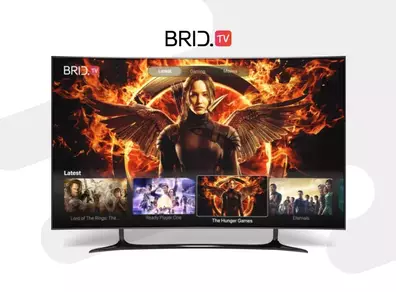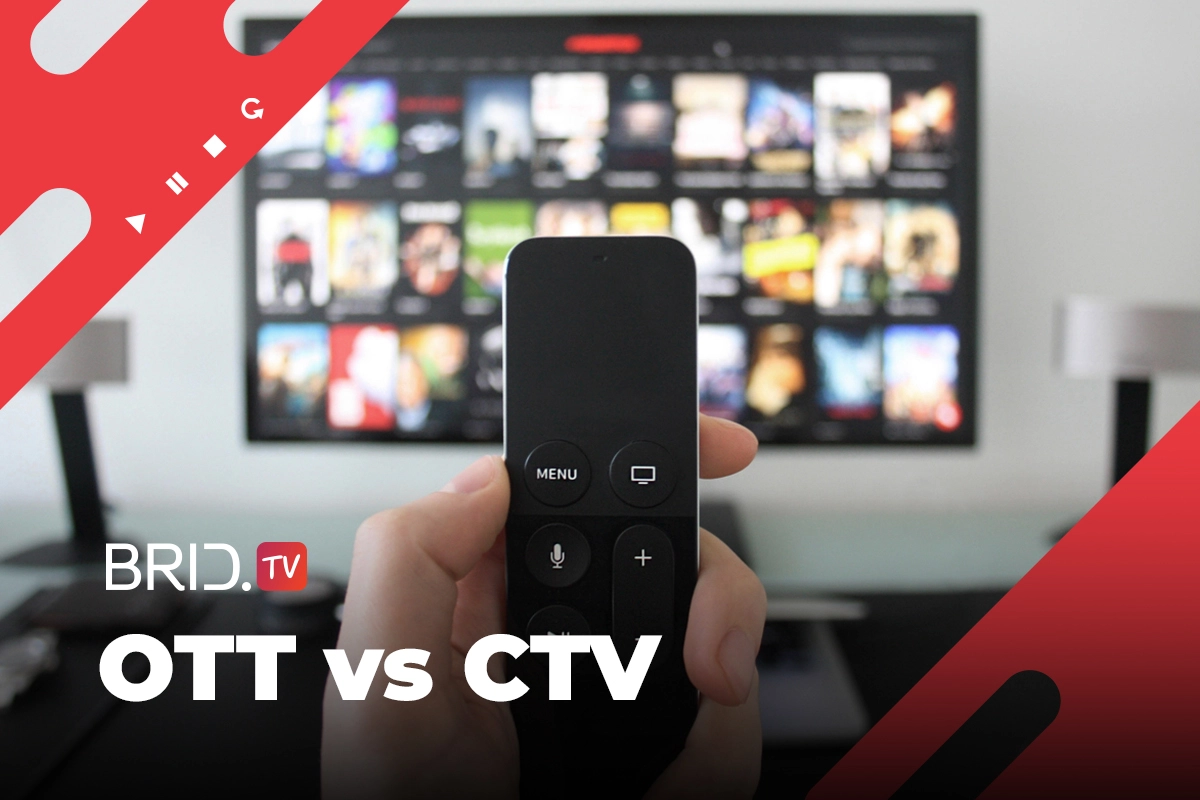For a clear-cut approach toward launching a streaming platform, it is essential to highlight the differences between OTT vs. CTV broadcasting channels. While working together in unity to deliver video content on connected TV devices, acting as two pieces of the same puzzle, their functions vary. To avoid using them interchangeably, we have decided to define and showcase the main differences between these two.
What Is OTT?
As opposed to cable and satellite TV providers, OTT, meaning “over-the-top,” is used to define streaming media services that deliver content via the internet through various mediums, i.e., “over the top” of these mediums — devices.
What makes OTT so unlike traditional media consumption is the flexibility and accessibility of these services. OTT caters to users, as they have total control over the content they view, unlike traditional media, where the providers control the content that gets distributed. In addition, users can easily connect to OTT services through apps and OTT boxes, with any mobile device, smart TV, PC, console, and so on.
OTT is nowadays the norm in many households, with the majority using platforms such as Netflix, Disney+, Hulu, HBO, and Amazon Prime Video for entertainment.
What Is CTV?
Connected TV (CTV) refers to television devices that connect to the Internet, giving users the ability to access streaming apps. CTV is the most popular way to access entertainment platforms such as Hulu and Netflix.
While distinctive from other devices that stream content, CTV technically falls into the subgroup of OTT devices. Many television sets already have CTV capabilities, but for those that don’t, external CTV components are used, such as TV boxes, TV sticks, and gaming consoles.
OTT vs. CTV — The Differences Explained!
Now that we have defined what both terms refer to, it’s time to highlight the difference between them. We can say that OTT is an online delivery channel for video content, while CTV is the medium – a type of OTT streaming device.
Simply put, the former refers to the streaming platforms themselves, and the latter is a device that allows users to access these streaming services.

OTT vs. CTV Advertising — What Is Better for Publishers
One of the main interests of streaming service publishers is how advertising fits in with these two channels. OTT and CTV advertisements are usually played before, during, and after the video the viewer is watching. The audience targeting system depends on the platform of choice and the data available. Based on this data, for example, demographics and user habits, specific ads are delivered to each household.
So far, we have established that OTT services are available on CTV devices, making them a package deal. However, there is an obvious advantage to integrating other types of OTT mediums, especially in advertising. Other OTT channels can also reach viewers that do not have a TV at home, for instance, on other mobile devices or desktop computers. Essentially, OTT advertising gives greater exposure to ads, which benefits both advertisers and publishers.
How to Get Started With OTT and CTV
With numerous successful launches of OTT, VOD, and live video platforms, it’s no wonder many publishers are looking to launch their streaming services. Here is some advice to get you started!
Choose an OTT Monetization Model That Fits You
There are many choices when it comes to OTT monetization strategies. From audience subscriptions (weekly, monthly, yearly) to free content monetized with ads, here is a look at some of the most popular video monetization models:
- Transaction-Based Monetization —Transaction-based monetization (TVOD) refers to individual transactions for specific content. A user pays to access this content, for example, a movie or a show. They are usually granted unlimited access or access for a certain amount of time or a certain number of viewings.
- Subscription-Based Monetization — Subscription-based monetization (SVOD) works on reoccurring transactions — in the form of weekly, monthly, or yearly payments. If you choose this option, your users will pay a certain fee regularly to access your platform. The most popular example of this monetization model is Netflix.
- Ad-Based Monetization — Ad-based monetization (AVOD) generates revenue from ads and not subscribers. Instead of your users paying subscription fees, they are granted access to your platform free of charge. This model fits those viewers that don’t mind seeing the occasional ad and don’t like paying for streaming services. OTT advertising is rapidly gaining popularity with advertisers as well!
Content Licensing Is a Must
One of the most important things when starting up OTT services is making sure that the content you plan on streaming has proper licensing to avoid copyright infringement.
You’ll need to request permission from content owners for further content distribution. You can distribute your own original content without a license, but be sure to protect it.
Protect Your Content
Keep your content safe from unauthorized access and piracy by implementing digital rights management (DRM). DRM is an essential tool for protecting copyrighted content from unauthorized distribution and editing. It helps you safeguard your content from specific devices and locations, disable screen recording, and more.
Find the Best OTT Platform for Your Needs
Launching streaming services can be a difficult task, especially when you’re new to the industry. Since every online video platform has a unique set of features and functionalities, including different pricing plans, finding the right OTT provider that matches your needs can be challenging. As previously mentioned, when choosing a provider, you need to take into consideration monetization options and security. However, many more factors come into play:
- Video Hosting — Hosting videos off-site is a necessity, so if an OTT platform offers this feature, it is worth the investment. Having a private video hosting service bundled up with your OTT package leaves you worry-free regarding storage space and gives you total control over content distribution and privacy.
- Content Management System — Highly functional content management systems are necessary for all content distributors, especially enterprise-level publishers. Quality video CMS will allow publishers to smoothly organize and embed their videos, as well as manage their workflow. These systems usually have multiple practical features like playlists, organizing videos by tags or categories, and many more.
- Detailed Analytics — Performance tracking plays an important role in your future success, so make sure that the OTT platform you choose has in-depth video analytics. With information such as video plays, views, video completions, average watch time, viewer demographics, and similar, you’ll be able to keep track of your strategy in real time.
- App Publication — Nowadays, it is practically impossible to develop a successful broadcasting business without an app. You can build one yourself or you can find a reliable video platform to do it for you. The most straightforward, time-saving, and cost-effective course of action is to go for a platform with white-label OTT apps. That way, all you have to do is customize and brand it to your taste, and you get to bypass all the costly development processes.
Get Started With TargetVideo
Now that we have outlined the difference between OTT and CTV and covered some of the common aspects of OTT platforms, it’s time to implement this knowledge into your strategy and get started with the launch of your streaming service.
Note that there are many additional features that some of the best OTT platforms in the business offer. On top of all the core features that many platforms provide, TargetVideo offers quality transcoding, API, a fully customizable HTML5 player, integrated quality ad demand, and more. Join TargetVideo and start today.

FAQ
1. What is the difference between CTV and OTT?
OTT is a distribution method for video content, while CTV is an internet-connected television device through which users can access and view this content.
2. What are examples of OTT and CTV?
Some of the best-known OTT examples include Netflix, Hulu, Amazon Prime Video, HBO, Peacock, Disney+, and YouTube. Popular CTV devices include smart TVs, Amazon Fire Sticks, and PlayStation.
